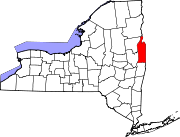Whitehall (village), New York
Whitehall | ||
|---|---|---|
Village | ||
FIPS code 36-81622[2] | | |
| GNIS feature ID | 0971145[3] | |
Whitehall is a
The village of Whitehall is located at the point where the Vermont border connects to the southern end of Lake Champlain.[5]
History

The village was founded in 1759 as "Skenesborough" by Major
On May 9, 1775, Lieutenant Samuel Herrick, leading as an advance party for
In 1776, General
The escaped murderer
During the War of 1812, the village was a shipbuilding community, supplying vessels for naval battles on Lake Champlain.
Historic sites and museums
- Skenesborough Museum
- USS Ticonderoga
- Cooke's Island
- Skene Manor
- Lock 12 of the Champlain Canal
- Main Street Historic District
- Judge Joseph Potter House
- US Post Office-Whitehall
- Whitehall Armory
Geography
According to the United States Census Bureau, the village has a total area of 4.8 square miles (12.5 km2), of which 4.7 square miles (12.1 km2) is land and 0.1 square mile (0.3 km2) (2.70%) is water.
U.S. Route 4 and NY Route 22 diverge at the village. Whitehall village is the northern end of the Champlain Canal, which connects the Hudson River to Lake Champlain.
Demographics
| Census | Pop. | Note | %± |
|---|---|---|---|
| 1870 | 4,322 | — | |
| 1880 | 4,270 | −1.2% | |
| 1890 | 4,434 | 3.8% | |
| 1900 | 4,377 | −1.3% | |
| 1910 | 4,917 | 12.3% | |
| 1920 | 5,258 | 6.9% | |
| 1930 | 5,191 | −1.3% | |
| 1940 | 4,851 | −6.5% | |
| 1950 | 4,457 | −8.1% | |
| 1960 | 4,016 | −9.9% | |
| 1970 | 3,764 | −6.3% | |
| 1980 | 3,241 | −13.9% | |
| 1990 | 3,071 | −5.2% | |
| 2000 | 2,667 | −13.2% | |
| 2010 | 2,614 | −2.0% | |
| 2020 | 2,465 | −5.7% | |
| U.S. Decennial Census[7] | |||
As of the
There were 1,104 households, out of which 30.8% had children under the age of 18 living with them, 45.9% were married couples living together, 12.7% had a female householder with no husband present, and 36.1% were non-families. 31.2% of all households were made up of individuals, and 15.9% had someone living alone who was 65 years of age or older. The average household size was 2.42 and the average family size was 3.01.
In the village, the population was spread out, with 25.9% under the age of 18, 8.8% from 18 to 24, 26.5% from 25 to 44, 21.2% from 45 to 64, and 17.6% who were 65 years of age or older. The median age was 38 years. For every 100 females, there were 90.4 males. For every 100 females age 18 and over, there were 86.9 males.
The median income for a household in the village was $31,667, and the median income for a family was $42,619. Males had a median income of $31,656 versus $20,417 for females. The
Rail transportation
Notable people
- Oliver Bascom (1815–1869), politician[citation needed]
- Henry G. Burleigh, United States Representative from New York[8]
References
- ^ "ArcGIS REST Services Directory". United States Census Bureau. Retrieved September 20, 2022.
- ^ a b c "U.S. Census website". United States Census Bureau. Retrieved January 31, 2008.
- ^ "US Board on Geographic Names". United States Geological Survey. October 25, 2007. Retrieved January 31, 2008.
- ^ "Metropolitan Areas and Components, 1999, with FIPS Codes". US Census Bureau. Retrieved July 7, 2009.
- ^ "Administrative boundary of Whitehall, NY from OSM". Retrieved April 4, 2014.
- ^ Hanson, Robert Brand (1976). Dedham, Massachusetts, 1635-1890. Dedham Historical Society. pp. 185–186.
- ^ "Census of Population and Housing". Census.gov. Retrieved June 4, 2015.
- ^ "BURLEIGH, Henry Gordon, (1832 – 1900)". Biographical Directory of the United States Congress. Retrieved January 16, 2014.
External links
- Whitehall Chamber of Commerce
- Whitehall Police Department
- Town of Whitehall
- New York State Heritage Areas
- Whitehall Website: Photos, Historical Info, & More
- Whitehall Volunteer Fire Company Website

